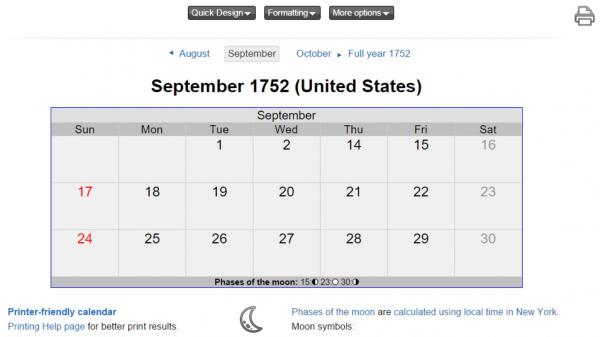Gregorian Calendar Reform: Why Are Some Dates Missing?
The Gregorian calendar, the calendar system we use today, was first introduced in 1582. To make up for the inaccuracies of its predecessor, the Julian calendar, a number of days had to be skipped.

The 1752 calendar change in North America
©timeanddate.com
How to convert between the Julian and Gregorian calendars
Too Many Leap Years
The Gregorian calendar, also known as the Western or Christian calendar, is the most widely used calendar in the world today.
Its predecessor, the Julian calendar, was replaced because it did not correctly reflect the actual time it takes the Earth to circle once around the Sun, known as a tropical year. In the Julian calendar, a leap day was added every four years, which is too frequent.
Although it is not perfect either, today's Gregorian calendar uses a much more accurate rule for calculating leap years.
Skipped Several Days
Over the centuries since its introduction in 45 BCE, the Julian calendar had gradually drifted away from astronomical events like the vernal equinox and the winter solstice. To make up for this error and get the calendar back in sync with the astronomical seasons, a number of days had to be dropped when the Gregorian calendar was adopted.
For example, in the British Empire, which at the time included its North American colonies, the month of September 1752 had only 19 days, as the day count went straight from September 2 to September 14 (see illustration).
Number of Lost Days Varied
The papal bull issued by Pope Gregory XIII in 1582 decreed that 10 days be skipped when switching to the Gregorian calendar. However, only five countries adopted the new calendar system that year—namely, Italy, Poland, Portugal, Spain, and most of France.
Since the discrepancy between the Julian calendar year and the astronomical seasons kept growing over time in the centuries that followed, more days had to be skipped in countries that switched to the Gregorian calendar in later years.
The US, Canada, and the UK dropped 11 days in 1752; Japan cut the year 1872 short by 12 days; and some countries, such as Russia, Greece, and Turkey, switched calendars as late as the early 20th century, so they had to omit 13 days (see table).
Switch Took More Than 300 Years
In total, more than three centuries passed until the Gregorian calendar had been adopted in all countries, from 1582 to 1927. The table below shows when the calendar reform occurred in some countries, including the first and the last.
Gregorian Calendar Introduction Worldwide
| Year of Switch | Country | Days Removed |
|---|---|---|
| 1582 | France (most areas), Italy, Poland, Portugal, Spain | 10 days |
| 1583 | Austria, Germany (Catholic states) | 10 days |
| 1587 | Hungary | 10 days |
| 1610 | Germany (Prussia) | 10 days |
| 1700 | Germany (Protestant areas), Switzerland (Protestant areas) | 10 days |
| 1752 | United States (most areas), Canada (most areas), United Kingdom (and colonies) | 11 days |
| 1872/1873 | Japan | 12 days |
| 1916 | Bulgaria | 13 days |
| 1918 | Estonia, Russia | 13 days |
| 1923 | Greece | 13 days |
| 1926/1927 | Turkey | 13 days |
Note: The list only includes countries that officially used the Julian calendar before the Gregorian calendar was introduced; countries that switched from a different calendar system to the Gregorian calendar, such as Saudi Arabia in 2016, are excluded. In some cases, it shows a simplified version of events. Each country is listed by its current name, although its official name may have changed since the calendar reform. | ||
Calendar Chaos
The delay in switching meant that countries followed different calendar systems for a number of years, resulting in differing leap year rules.
In the Gregorian calendar, most years that are evenly divisible by 100 are common years, but they are leap years in the Julian calendar. This meant that the years 1700, 1800, and 1900 were leap years in countries still using the Julian calendar at the time (e.g., Greece), while in countries that had adopted the Gregorian calendar (e.g., Germany), these years were common years.
Double Leap Year
The Swedish Empire, roughly comprising the areas of today’s Sweden and Finland, even had a “double” leap year in 1712. Two days were added to February, creating February 30, 1712, after the leap day in 1700 had erroneously been dropped, and the calendar was not synchronized with either the Julian or the Gregorian system. By adding an extra leap day in 1712, they were back on the Julian calendar. The Gregorian calendar was introduced in 1753.
Many Variations
In some non-western countries, the calendar reform took on many different guises to accommodate differing cultural and historical contexts. For example, Japan replaced its lunisolar calendar with the Gregorian calendar in January 1873 but decided to use the numbered months it had originally used rather than the European names.
The Republic of China (1912-1949) initially adopted the Gregorian calendar in January 1912, but it wasn’t actually used due to warlords using different calendars. However, the Nationalist Government (1928-1949) formally decreed the adoption of the Gregorian calendar in China in January 1929.
Conversion between Julian and Gregorian Calendars
Currently, the Julian calendar is 13 days behind the Gregorian calendar. So, to convert from the Julian calendar to the Gregorian calendar, add 13 days; to convert in the opposite direction, subtract 13 days.
The gap between the two calendar systems will increase to 14 days in the year 2100.